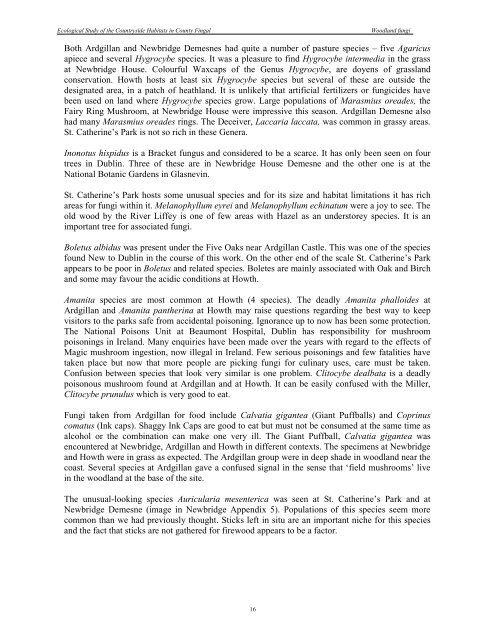2006 Fungi of Fingal Woodlands - Fingal Biodiversity
2006 Fungi of Fingal Woodlands - Fingal Biodiversity
2006 Fungi of Fingal Woodlands - Fingal Biodiversity
You also want an ePaper? Increase the reach of your titles
YUMPU automatically turns print PDFs into web optimized ePapers that Google loves.
Ecological Study <strong>of</strong> the Countryside Habitats in County <strong>Fingal</strong> Woodland fungi<br />
Both Ardgillan and Newbridge Demesnes had quite a number <strong>of</strong> pasture species – five Agaricus<br />
apiece and several Hygrocybe species. It was a pleasure to find Hygrocybe intermedia in the grass<br />
at Newbridge House. Colourful Waxcaps <strong>of</strong> the Genus Hygrocybe, are doyens <strong>of</strong> grassland<br />
conservation. Howth hosts at least six Hygrocybe species but several <strong>of</strong> these are outside the<br />
designated area, in a patch <strong>of</strong> heathland. It is unlikely that artificial fertilizers or fungicides have<br />
been used on land where Hygrocybe species grow. Large populations <strong>of</strong> Marasmius oreades, the<br />
Fairy Ring Mushroom, at Newbridge House were impressive this season. Ardgillan Demesne also<br />
had many Marasmius oreades rings. The Deceiver, Laccaria laccata, was common in grassy areas.<br />
St. Catherine’s Park is not so rich in these Genera.<br />
Inonotus hispidus is a Bracket fungus and considered to be a scarce. It has only been seen on four<br />
trees in Dublin. Three <strong>of</strong> these are in Newbridge House Demesne and the other one is at the<br />
National Botanic Gardens in Glasnevin.<br />
St. Catherine’s Park hosts some unusual species and for its size and habitat limitations it has rich<br />
areas for fungi within it. Melanophyllum eyrei and Melanophyllum echinatum were a joy to see. The<br />
old wood by the River Liffey is one <strong>of</strong> few areas with Hazel as an understorey species. It is an<br />
important tree for associated fungi.<br />
Boletus albidus was present under the Five Oaks near Ardgillan Castle. This was one <strong>of</strong> the species<br />
found New to Dublin in the course <strong>of</strong> this work. On the other end <strong>of</strong> the scale St. Catherine’s Park<br />
appears to be poor in Boletus and related species. Boletes are mainly associated with Oak and Birch<br />
and some may favour the acidic conditions at Howth.<br />
Amanita species are most common at Howth (4 species). The deadly Amanita phalloides at<br />
Ardgillan and Amanita pantherina at Howth may raise questions regarding the best way to keep<br />
visitors to the parks safe from accidental poisoning. Ignorance up to now has been some protection.<br />
The National Poisons Unit at Beaumont Hospital, Dublin has responsibility for mushroom<br />
poisonings in Ireland. Many enquiries have been made over the years with regard to the effects <strong>of</strong><br />
Magic mushroom ingestion, now illegal in Ireland. Few serious poisonings and few fatalities have<br />
taken place but now that more people are picking fungi for culinary uses, care must be taken.<br />
Confusion between species that look very similar is one problem. Clitocybe dealbata is a deadly<br />
poisonous mushroom found at Ardgillan and at Howth. It can be easily confused with the Miller,<br />
Clitocybe prunulus which is very good to eat.<br />
<strong>Fungi</strong> taken from Ardgillan for food include Calvatia gigantea (Giant Puffballs) and Coprinus<br />
comatus (Ink caps). Shaggy Ink Caps are good to eat but must not be consumed at the same time as<br />
alcohol or the combination can make one very ill. The Giant Puffball, Calvatia gigantea was<br />
encountered at Newbridge, Ardgillan and Howth in different contexts. The specimens at Newbridge<br />
and Howth were in grass as expected. The Ardgillan group were in deep shade in woodland near the<br />
coast. Several species at Ardgillan gave a confused signal in the sense that ‘field mushrooms’ live<br />
in the woodland at the base <strong>of</strong> the site.<br />
The unusual-looking species Auricularia mesenterica was seen at St. Catherine’s Park and at<br />
Newbridge Demesne (image in Newbridge Appendix 5). Populations <strong>of</strong> this species seem more<br />
common than we had previously thought. Sticks left in situ are an important niche for this species<br />
and the fact that sticks are not gathered for firewood appears to be a factor.<br />
16


